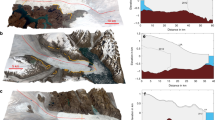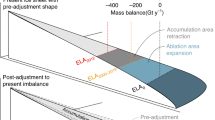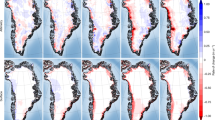Abstract
The Greenland Ice Sheet (GIS) is losing mass at a high rate1. Given the short-term nature of the observational record, it is difficult to assess the historical importance of this mass-loss trend. Unlike records of greenhouse gas concentrations and global temperature, in which observations have been merged with palaeoclimate datasets, there are no comparably long records for rates of GIS mass change. Here we reveal unprecedented mass loss from the GIS this century, by placing contemporary and future rates of GIS mass loss within the context of the natural variability over the past 12,000 years. We force a high-resolution ice-sheet model with an ensemble of climate histories constrained by ice-core data2. Our simulation domain covers southwestern Greenland, the mass change of which is dominated by surface mass balance. The results agree favourably with an independent chronology of the history of the GIS margin3,4. The largest pre-industrial rates of mass loss (up to 6,000 billion tonnes per century) occurred in the early Holocene, and were similar to the contemporary (ad 2000–2018) rate of around 6,100 billion tonnes per century5. Simulations of future mass loss from southwestern GIS, based on Representative Concentration Pathway (RCP) scenarios corresponding to low (RCP2.6) and high (RCP8.5) greenhouse gas concentration trajectories6, predict mass loss of between 8,800 and 35,900 billion tonnes over the twenty-first century. These rates of GIS mass loss exceed the maximum rates over the past 12,000 years. Because rates of mass loss from the southwestern GIS scale linearly5 with the GIS as a whole, our results indicate, with high confidence, that the rate of mass loss from the GIS will exceed Holocene rates this century.
This is a preview of subscription content, access via your institution
Access options
Access Nature and 54 other Nature Portfolio journals
Get Nature+, our best-value online-access subscription
$29.99 / 30 days
cancel any time
Subscribe to this journal
Receive 51 print issues and online access
$199.00 per year
only $3.90 per issue
Buy this article
- Purchase on Springer Link
- Instant access to full article PDF
Prices may be subject to local taxes which are calculated during checkout




Similar content being viewed by others
Data availability
Original data published here are ice-sheet model output (Gt per century and Gt per year) and modified palaeoclimate data from ref. 2, which are available at https://www.ncdc.noaa.gov/paleo/study/30172. The simulations we performed made use of the open-source ISSM and are available at https://issm.jpl.nasa.gov/ (last access 1 July 2019)21.
References
The IMBIE Team. Mass balance of the Greenland Ice Sheet from 1992 to 2018. Nature 579, 233–239 (2020).
Badgeley, J. A., Steig, E. J., Hakim, G. J. & Fudge, T. J. Greenland temperature and precipitation over the last 20,000 years using data assimilation. Clim. Past 16, 1325–1346 (2020).
Lesnek, A. J., Briner, J. P., Young, N. E. & Cuzzone, J. K. Maximum southwest Greenland Ice Sheet recession in the early Holocene. Geophys. Res. Lett. 47, e2019GL083164 (2020).
Young, N. E. et al. Deglaciation of the Greenland and Laurentide ice sheets interrupted by glacier advance during abrupt coolings. Quat. Sci. Rev. 229, 106091 (2020).
Mouginot, J. et al. Forty-six years of Greenland Ice Sheet mass balance from 1972 to 2018. Proc. Natl Acad. Sci. USA 116, 9239–9244 (2019).
Pörtner, H.-O. et al. (eds) IPCC Special Report on the Ocean and Cryosphere in a Changing Climate Ch. 3 (2019); https://www.ipcc.ch/srocc/
Bevis, M. et al. Accelerating changes in ice mass within Greenland, and the ice sheet’s sensitivity to atmospheric forcing. Proc. Natl Acad. Sci. USA 116, 1934–1939 (2019).
Kjeldsen, K. K. et al. Spatial and temporal distribution of mass loss from the Greenland Ice Sheet since ad 1900. Nature 528, 396–400 (2015).
Golledge, N. R. et al. Global environmental consequences of twenty-first-century ice-sheet melt. Nature 566, 65–72 (2019).
Box, J. E. & Colgan, W. Greenland Ice Sheet mass balance reconstruction. Part III: marine ice loss and total mass balance (1840–2010). J. Clim. 26, 6990–7002 (2013).
Robinson, A., Calov, R. & Ganopolski, A. Multistability and critical thresholds of the Greenland ice sheet. Nat. Clim. Chang. 2, 429–432 (2012).
Koenig, S. J., DeConto, R. M. & Pollard, D. Impact of reduced Arctic sea ice on Greenland ice sheet variability in a warmer than present climate. Geophys. Res. Lett. 41, 3933–3942 (2014).
Aschwanden, A. et al. Contribution of the Greenland Ice Sheet to sea level over the next millennium. Sci. Adv. 5, eaav9396 (2019).
Sinclair, G. et al. Diachronous retreat of the Greenland ice sheet during the last deglaciation. Quat. Sci. Rev. 145, 243–258 (2016).
Tarasov, L. & Richard Peltier, W. Greenland glacial history and local geodynamic consequences. Geophys. J. Int. 150, 198–229 (2002).
Simpson, M. J. R., Milne, G. A., Huybrechts, P. & Long, A. J. Calibrating a glaciological model of the Greenland ice sheet from the Last Glacial Maximum to present-day using field observations of relative sea level and ice extent. Quat. Sci. Rev. 28, 1631–1657 (2009).
Lecavalier, B. S. et al. A model of Greenland ice sheet deglaciation constrained by observations of relative sea level and ice extent. Quat. Sci. Rev. 102, 54–84 (2014).
Briner, J. P. et al. Holocene climate change in Arctic Canada and Greenland. Quat. Sci. Rev. 147, 340–364 (2016).
Buizert, C. et al. Greenland-wide seasonal temperatures during the last deglaciation. Geophys. Res. Lett. 45, 1905–1914 (2018).
Nielsen, L. T., Aðalgeirsdóttir, Gu., Gkinis, V., Nuterman, R. & Hvidberg, C. S. The effect of a Holocene climatic optimum on the evolution of the Greenland ice sheet during the last 10 kyr. J. Glaciol. 64, 477–488 (2018).
Larour, E., Seroussi, H., Morlighem, M. & Rignot, E. Continental scale, high order, high spatial resolution, ice sheet modeling using the Ice Sheet System Model (ISSM). J. Geophys. Res. Earth Surf. 117, F01022 (2012).
Cuzzone, J. K., Morlighem, M., Larour, E., Schlegel, N. & Seroussi, H. Implementation of higher-order vertical finite elements in ISSM v4.13 for improved ice sheet flow modeling over paleoclimate timescales. Geosci. Model Dev. 11, 1683–1694 (2018).
Cuzzone, J. K. et al. The impact of model resolution on the simulated Holocene retreat of the southwestern Greenland ice sheet using the Ice Sheet System Model (ISSM). Cryosphere 13, 879–893 (2019).
Downs, J. et al. Western Greenland ice sheet retreat history reveals elevated precipitation during the Holocene thermal maximum. Cryosphere 14, 1121–1137 (2020).
Åkesson, H., Nisancioglu, K. H. & Morlighem, M. Simulating the evolution of Hardangerjøkulen ice cap in southern Norway since the mid-Holocene and its sensitivity to climate change. Cryosphere 11, 281–302 (2017).
Rignot, E. & Mouginot, J. Ice flow in Greenland for the International Polar Year 2008–2009. Geophys. Res. Lett. 39, L11501 (2012).
Morlighem, M. et al. Modeling of Store Gletscher’s calving dynamics, West Greenland, in response to ocean thermal forcing. Geophys. Res. Lett. 43, 2659–2666 (2016).
.Weidick, A. Observations on some Holocene glacier fluctuations in West Greenland. Medd. Gronl. 165 (1968).
Larsen, N. K. et al. Rapid early Holocene ice retreat in West Greenland. Quat. Sci. Rev. 92, 310–323 (2014).
Lecavalier, B. S. et al. High Arctic Holocene temperature record from the Agassiz ice cap and Greenland ice sheet evolution. Proc. Natl Acad. Sci. USA 114, 5952–5957 (2017).
Pendleton, S., Miller, G., Lifton, N. & Young, N. Cryosphere response resolves conflicting evidence for the timing of peak Holocene warmth on Baffin Island, Arctic Canada. Quat. Sci. Rev. 216, 107–115 (2019).
McKay, N. P., Kaufman, D. S., Routson, C. C., Erb, M. P. & Zander, P. D. The onset and rate of Holocene neoglacial cooling in the arctic. Geophys. Res. Lett. 45, 12,487–12,496 (2018).
Solignac, S., Giraudeau, J. & de Vernal, A. Holocene sea surface conditions in the western North Atlantic: spatial and temporal heterogeneities. Paleoceanography 21, PA2004 (2006).
Gibb, O. T., Steinhauer, S., Fréchette, B., de Vernal, A. & Hillaire-Marcel, C. Diachronous evolution of sea surface conditions in the Labrador Sea and Baffin Bay since the last deglaciation. Holocene 25, 1882–1897 (2015).
Box, J. E. Greenland Ice Sheet mass balance reconstruction. Part II: surface mass balance (1840–2010). J. Clim. 26, 6974–6989 (2013).
Goelzer, H. et al. The future sea-level contribution of the Greenland ice sheet: a multi-model ensemble study of ISMIP6. Cryosphere Discuss. https://doi.org/10.5194/tc-2019-319 (2020).
Morlighem, M. et al. BedMachine v3: complete bed topography and ocean bathymetry mapping of Greenland from multi-beam echo sounding combined with mass conservation. Geophys. Res. Lett. 44, 11051–11061 (2017).
Blatter, H. Velocity and stress fields in grounded glaciers: a simple algorithm for including deviatoric stress gradients. J. Glaciol. 41, 333–344 (1995).
Pattyn, F. A new three-dimensional higher-order thermomechanical ice sheet model: Basic sensitivity, ice stream development, and ice flow across subglacial lakes. J. Geophys. Res. Solid Earth 108, 2382 (2003).
Aschwanden, A., Bueler, E., Khroulev, C. & Blatter, H. An enthalpy formulation for glaciers and ice sheets. J. Glaciol. 58, 441–457 (2012).
Shapiro, N. M. & Ritzwoller, M. H. Inferring surface heat flux distributions guided by a global seismic model: particular application to Antarctica. Earth Planet. Sci. Lett. 223, 213–224 (2004).
Morlighem, M. et al. Spatial patterns of basal drag inferred using control methods from a full-Stokes and simpler models for Pine Island Glacier, West Antarctica. Geophys. Res. Lett. 37, L14502 (2010).
Åkesson, H., Morlighem, M., Nisancioglu, K. H., Svendsen, J. I. & Mangerud, J. Atmosphere-driven ice sheet mass loss paced by topography: Insights from modelling the south-western Scandinavian Ice Sheet. Quat. Sci. Rev. 195, 32–47 (2018).
Cuffey, K. M. & Paterson, W. S. B. The Physics of Glaciers (Academic Press, 2010).
Seroussi, H. et al. Dependence of century-scale projections of the Greenland ice sheet on its thermal regime. J. Glaciol. 59, 1024–1034 (2013).
Liu, Z. et al. Transient simulation of last deglaciation with a new mechanism for Bølling-Allerød warming. Science 325, 310–314 (2009).
He, F. et al. Northern Hemisphere forcing of Southern Hemisphere climate during the last deglaciation. Nature 494, 81–85 (2013).
Tarasov, L. & Peltier, W. R. Impact of thermomechanical ice sheet coupling on a model of the 100 kyr ice age cycle. J. Geophys. Res. Atmos. 104, 9517–9545 (1999).
Janssens, I. & Huybrechts, P. The treatment of meltwater retention in mass-balance parameterizations of the Greenland ice sheet. Ann. Glaciol. 31, 133–140 (2000).
Le Morzadec, K., Tarasov, L., Morlighem, M. & Seroussi, H. A new sub-grid surface mass balance and flux model for continental-scale ice sheet modelling: testing and last glacial cycle. Geosci. Model Dev. 8, 3199–3213 (2015).
Dansgaard, W. et al. Evidence for general instability of past climate from a 250-kyr ice-core record. Nature 364, 218–220 (1993).
Howat, I. M., Negrete, A. & Smith, B. E. The Greenland Ice Mapping Project (GIMP) land classification and surface elevation data sets. Cryosphere 8, 1509–1518 (2014).
Young, N. E. & Briner, J. P. Holocene evolution of the western Greenland Ice Sheet: Assessing geophysical ice-sheet models with geological reconstructions of ice-margin change. Quat. Sci. Rev. 114, 1–17 (2015).
Courant, R., Friedrichs, K. & Lewy, H. Über die partiellen Differenzengleichungen der mathematischen Physik. Math. Ann. 100, 32–74 (1928).
Caron, L. et al. GIA model statistics for GRACE hydrology, cryosphere, and ocean science. Geophys. Res. Lett. 45, 2203–2212 (2018).
Nowicki, S. M. J. et al. Ice Sheet Model Intercomparison Project (ISMIP6) contribution to CMIP6. Geosci. Model Dev. 9, 4521–4545 (2016).
Noël, B. et al. Evaluation of the updated regional climate model RACMO2.3: summer snowfall impact on the Greenland Ice Sheet. Cryosphere 9, 1831–1844 (2015).
Nowicki, S. et al. Experimental protocol for sea level projections from ISMIP6 standalone ice sheet models. Cryosphere Discuss. https://doi.org/10.5194/tc-2019-322 (2020).
Acknowledgements
We acknowledge field logistical support by CH2MHill Polar Field Services. We acknowledge support by NSF-Arctic System Sciences grants ARC-1504267 to J.P.B., B.C. and E.K.T., ARC-1503281 to E.J.S. and G.J.H., ARC-1504230 to M.M., ARC-1503959 to N.E.Y. and J.M.S., and ARC-1504457 to J.V.J.; and NSF-Earth Sciences Instrumentation and Facilities grant 1652274 to E.K.T. J.A.B. acknowledges NSF Graduate Research Fellowship (DGE-1256082); A.A.C. acknowledges NSF Graduate Research Fellowship (DGE-1645677). A.d.V. and E.A. acknowledge support from the Natural Sciences and Engineering Council of Canada (NSERC) and the Fonds de Recherche du Québec - Nature et Technologie (FRQNT). S.N. acknowledge support from the NASA Sea Level Change Team and Cryosphere Sciences Programs. J.M.S. acknowledges support by the Unger Vetlesen Foundation and the Columbia Climate Center. This is LDEO contribution number 8436.
Author information
Authors and Affiliations
Contributions
The project was conceived by J.P.B., N.E.Y., J.M.S., E.K.T., B.C., E.J.S., G.J.H., M.M., E.L. and J.V.J. J.P.B., J.K.C., J.A.B. and E.J.S. wrote the first draft of the manuscript. All authors commented on and edited the manuscript. N.E.Y., E.K.T. and J.P.B. led the fieldwork, with contributions from O.B., A.A.C., A.J.L., J.K.C. and J.A.B. J.K.C. led ice-sheet modelling with N.-J.S., E.L., M.M., J.V.J. and J.D. J.A.B. led climate forcing with E.J.S. and G.J.H. A.J.L., J.K.C. and J.P.B. carried out the data–model comparison. A.d.V. and E.A. provided information on sea-surface conditions. S.N. led ISMIP6 climate forcing used in this study.
Corresponding author
Ethics declarations
Competing interests
The authors declare no competing interests.
Additional information
Peer review information Nature thanks Andy Aschwanden and the other, anonymous, reviewer(s) for their contribution to the peer review of this work.
Publisher’s note Springer Nature remains neutral with regard to jurisdictional claims in published maps and institutional affiliations.
Extended data figures and tables
Extended Data Fig. 1 Precipitation forcing for the Holocene ice-sheet simulation.
The area-averaged (over model domain) mean annual precipitation is shown for three different reconstructions2.
Extended Data Fig. 2 Temperature forcing for the Holocene ice-sheet simulation.
The area-averaged (over model domain) mean annual temperature is shown for three different reconstructions2.
Extended Data Fig. 3 Basal-friction sensitivity experiment.
The map shows the difference in the friction coefficient between the model using a friction coefficient proportional to the bedrock topography and a model using a friction coefficient derived by extrapolation. Red shows where the friction coefficient proportional to the bedrock topography is higher than the friction coefficient derived from extrapolation.
Extended Data Fig. 4 Sensitivity experiment showing the influence of basal friction on simulated GIS mass change.
The simulated ice-mass change (Gt per century) in the Holocene is shown using climatologies from model run 1 (Extended Data Table 1), with reference friction coefficients outside the present-day ice margin derived as a function of the bed topography (red) or as an extrapolation of friction coefficients (blue).
Extended Data Fig. 5 Climatology sensitivity experiment.
The simulated ice-mass change (Gt per century) in the Holocene is shown using two different reference climatologies (monthly mean) of temperature and precipitation from ref. 35, to which the temperature and precipitation anomalies from ref. 2 are applied. Blue, simulated ice-mass change using the ad 1850–2000-mean reference climatology (the same reference period as in ref. 2); red, simulated ice-mass change using the ad 1850–1950-mean reference climatology. The climate anomalies2 applied to the reference climatologies are the same as for model run 7 (Extended Data Table 1).
Extended Data Fig. 6 Data–model comparison of ice-margin change.
a, Maps showing the simulated (blue) and observed (black; from geologic reconstruction) ice margin for model simulation 7. b, Maps showing the simulated (green) and observed (black; from geologic reconstruction) ice margin for model simulation 1. See Extended Data Table 1 for a description of the model simulations. ka, thousand years ago.
Extended Data Fig. 7 Goodness-of-fit exercise in the area with detailed moraine records.
a–g, Comparison of modelled and reconstructed ice margins in the northern domain (a) at six different time slices (b–g). Field-reconstructed ice margins3 are represented by the black lines. Simulated ice margins not shown in b are at the domain boundary or coastline; some margins in d lie beneath other margins, making them invisible; dashed lines demarcate the comparison domain.
Rights and permissions
About this article
Cite this article
Briner, J.P., Cuzzone, J.K., Badgeley, J.A. et al. Rate of mass loss from the Greenland Ice Sheet will exceed Holocene values this century. Nature 586, 70–74 (2020). https://doi.org/10.1038/s41586-020-2742-6
Received:
Accepted:
Published:
Issue Date:
DOI: https://doi.org/10.1038/s41586-020-2742-6
This article is cited by
-
Ubiquitous acceleration in Greenland Ice Sheet calving from 1985 to 2022
Nature (2024)
-
Arctic mercury flux increased through the Last Glacial Termination with a warming climate
Nature Geoscience (2023)
-
Freshwater forcing of the Atlantic Meridional Overturning Circulation revisited
Nature Climate Change (2022)
-
Stability of the Antarctic Ice Sheet during the pre-industrial Holocene
Nature Reviews Earth & Environment (2022)
-
Discrepancies between observations and climate models of large-scale wind-driven Greenland melt influence sea-level rise projections
Nature Communications (2022)
Comments
By submitting a comment you agree to abide by our Terms and Community Guidelines. If you find something abusive or that does not comply with our terms or guidelines please flag it as inappropriate.



